
Streamside Systems, LLC
Streamside Systems has adapted the company’s patented ‘Collector’
technology – typically used for prevention and restoration of
sedimentation impacts on streams – for use by cattle farms using sand
for bedding.
Streamside Systems, LLC
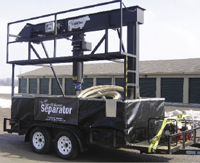
|
Streamside Systems has adapted the company’s patented ‘Collector’ technology – typically used for prevention and restoration of sedimentation impacts on streams – for use by cattle farms using sand for bedding. The conversion of this existing technology to dairy operations allows for a completely new approach to separation. The low maintenance, unmanned modular system is capable of removing up to 100 yards of sand, 0.25mm and larger per day from up to 2000gpm dairy outflows. The system has no augers, gearboxes, motors or motor controls to maintain, and is designed from durable stainless steel to reduce wear and maintenance. It is available in pumped above ground units or in-flow gravity units. According to independent testing performed at Colorado State University’s Hydraulics Laboratory, the Streamside Systems Collector has been documented at up to 99 percent capture efficiency for particles greater than 0.25mm. For improved sand removal, multiple collection drops can be used in series to further increase sediment capture and removal efficiency.
Streamside lists advantages of its new technology, including: reduced labor costs, sustainable recycling and beneficial reuse of clean-washed sand, dilution of manure streams for improved separation and treatment, reduction in volume requirements for waste storage, extending lagoon lifespan, potential increase in herd size, and corresponding operating cost reduction and increased profitability.
www.streamsidesystems.com
North Star Manufacturing
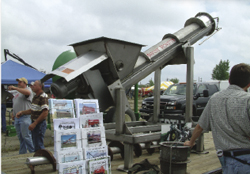 |
North Star Manufacturing, based in northwest Iowa, produces the Manure Monster, a separation and dewatering system for the dairy industry. The Monster is a screw press constructed entirely from stainless steel, except the carbon steel auger. The auger, which is connected directly to the motor/gearbox to eliminate the need for belts and chains, operates inside a stainless steel tube, which is cut in a specific slot pattern. At the end of the tube is a specially designed ‘basket’ with a weighted door system. The basket end is free floating, giving it the flexibility to handle foreign objects, such as ear tags, wood and rocks, up to 2.5in in size without being damaged. The elevated design of the tube allows gravity to be used in the dewatering process. In most cases, solids exiting the Manure Monster are in the 60 to 65 percent moisture range. The liquid manure can be loaded using the Monster’s 300gal hopper or replace the hopper with North Star’s specially designed pump lid. Exit water can be directed to a lagoon or storage tank while the solids are stacked. The Monster works best in a dairy where organic materials are used for bedding.
The Manure Monster is portable or can be installed in-line. Two models are available: the 5.0hp and the 10hp. Capacity ranges from 25gpm to 125gpm, depending on the percent and type of solids in the waste stream.
www.gotmanure.com
Kyte Centrifuge
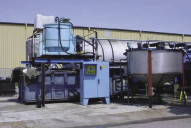 |
The Triton Separator is a solid bowl basket centrifuge system that can be used on flushed swine, dairy or poultry manure and lagoon sludges. The discharged centrifuge manure solids cake is truckable at up to 31 percent dry matter and can be applied to the fields or dried and recycled as bedding. The system comes in two sizes and is also suitable as a manure separator/thickening device prior to anaerobic digestion. Maximum feed rates are 50gpm to 75gpm or 72,000gpd to 108,000gpd. Typically the Triton Separator removes 70 to 85 percent of suspended solids in fresh flushed swine or dairy manure and can accept a wide variety of manure slurry feed rates, feed solids concentrations and feed materials. Preliminary phosphate removal studies indicate that 60 to 75 percent of phosphates are removed with the cake discharge. It is recommended a coarse screener be in place prior to the centrifuge to remove oversize material and non-organic debris. The system is easy to use and no full-time operator is required. The Triton Separator has no gearbox or internal conveyor, has no filter media and no filter belts or cloths to replace. No coagulants are required. It has an uncomplicated design and operates with simple push button on/off capabilities. Start-up assistance is included with the order.
www.kcentrifuge.com
J. Houle & Sons
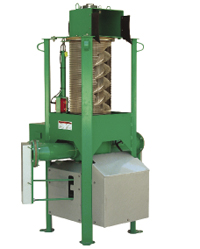 |
J. Houle & Sons Liquid Manure Dewaterer has the flexibility needed for use in various manure management situations. Between a flush flume system and a digester, the filtrated liquid discharge from the dewaterer can be recycled back in the flush flume pit, decreasing or eliminating the need for additional water normally needed to make the flush flume cycle efficient. The wet fibers discharged from the dewaterer can be partially liquefied with the volume of flush flume liquid disposed of every day. This creates a thick mix, which can then be scraped into the digester. The thicker the mix, the more methane produced.
For scraped manure, the dewaterer can be used to supply wet fibers with 82 to 83 percent moisture to the Houle 2-roller press to make compost in arid climates. For digested manure, the dewaterer system can be used to supply wet fibers with 82 to 83 percent moisture to the Houle 5-press to make compost in humid countries or to make cow bedding.
Houle’s Liquid Manure Dewaterer works using gravity. The vertical auger lifts the wet fibers to the top discharge while the filtrated liquid is directed to the roller press bottom liquid collector or flush flume pit. The dewaterer can process scraped manure at a rate of about three cows per minute and can process digested manure at a rate of five cows per minute. It operates using a 3.0hp electric motor and has a belt drive for speed reduction.
www.jhoule.com
Accent Manufacturing
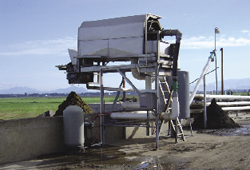
|
Accent Manufacturing’s IFRS 36 separator was specifically designed for hog and dairy manure handling. The 36in rotary screen separator is suitable for all types of bedding material, including sand, and performs in both flush and scrape manure conditions. It is also suited for operation within a bio-digester system as a thickener and dewatering unit.
The IFRS 36 is constructed using high quality stainless steel and designed with no belts or chains, providing reliable operation and low maintenance. It features a Vector Drive VFD/gearbox to maximize through put capacity, ensure positive high load starting and low speed ramp-up starting. Its Delrin engineered bearings require no lubrication and provide trouble-free operation. The unit’s drive wheels feature a
one-piece solid stainless hub and a vulcanized natural traction surface, ensuring improved longevity and durability, positive traction and maximized wear life.
Accent separators are designed to remove a high percentage of solids, reduce the production of greenhouse gases, decrease nutrient levels in effluent, improve biochemical and chemical oxygen demand levels in effluent, reduce the cost of downstream treatment of manure and achieve exportable solid fraction.
www.accentmanufacturing.com
Bauer
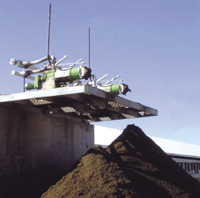 |
Farms with high animal concentrations are faced with the challenge of dealing with large amounts of slurry. But customary slurry treatment systems can be time-consuming, labor intensive and require enormous financial investment. Bauer’s S655 and S855 separators can convert slurry into a valuable fertilizer. The fully automatic separation process that splits the slurry into a liquid and solid fraction offers great advantages. The slurry volume is reduced by 15 to 30 percent, meaning less liquid storage space is needed. Odors are reduced and no crusting occurs, thus no need to agitate. The resulting solid fraction is odorless, easy to store, can be further dried and recycled as bedding, is self-composting and can help improve soil structure while increasing humus content.
Bauer’s S655 can handle up to 90gpm of cattle slurry and 110gpm of swine slurry. The S855 can accommodate up to 140gpm of cattle slurry and 170gpm of swine slurry. Both press screw-style units are constructed using coated stainless steel with a stainless steel slotted screen cylinder. Various slot sizes are available. The separators have weight-loaded discharge flaps and can be mounted on a frame for permanent or portable installation. Both are also available in heavy-duty models.
www.bauer-at.com
FAN Separator
 |
FAN Separator has decided to take manure separation and solids recycling one step further with the development of the FAN Bedding Recovery Unit (BRU). The unit provides internally created bedding material recycled from manure solids already at the farm. The bedding is produced fresh daily, needs no extra storage area and does not increase the total amount of manure solids.
The FAN BRU includes two steps. The first step involves the separation of large fibers from the manure. These fibers are mainly undigested parts of feed, such as corn silage or hay. A specially designed press screw separator removes the large fibers and lowers the moisture content of the material. The solids are fed continuously with a screw conveyor into the FAN Compost Drum, where the second step of the process takes place. Here, the solids are treated in an intensive aerobic process for drying and cleaning the material. The process ensures a homogeneous product that is treated in a controlled process. The chemistry of the product is modified from that of fresh manure and counteracts the mastitis-producing micro-organisms found in fresh manure.
Components of the BRU system include a submersible pump with a mixing device, a FAN Press Screw Separator, a feeding auger, a FAN Compost Drum Dryer in an insulated container and an exhaust air fan with automatic speed control. Each system is sized to serve a dairy operation of about 1000 cows.
www.fan-separator.com
McLanahan Corporation
The McLanahan Sand-Manure Separator (SMS) removes bedding sand from dairy manure, resulting in a manure fraction capable of being stored long-term plus a sand fraction that can be reused as bedding.
In scrape systems, the sand-laden manure is scraped from the alleys into a reception pit. The material is then augered into the SMS unit. With flush systems, the flush stream is diverted into a settling area where the sand and manure solids can settle. The settled solids are then conveyed into the SMS. Sand discharged from the unit contains about 10 to 12 percent moisture and is damp to the touch Recovered sand typically contains very low levels of organic matter, usually less than two percent. Once the sand is removed, the manure fraction can
be pumped, irrigated or injected. It can also be pumped through a liquid/solid separator before being stored or reused as make-up water.
The McLanahan SMS is available in two models: the SMS-20 (five cows per hour capacity) and the SMS-36 (10 cows per hour capacity). Both are constructed from steel plate with gussets and stiffening ribs to provide a high degree of stiffness and rigidity.
www.mclanahan.com
CAWI Canada
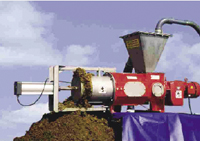 |
The MAS-1 screw press filter from CAWI Canada is a second-generation screw press filter. There is no high pressure on the filter, meaning there is almost no maintenance or replacement of expensive screen filters required. The MAS-1 is equipped with an SS grove filter, available in 0.15mm to 1.0mm. The unit’s unique air-controlled shutter ensures constant, quality output. In the unlikely event of a water breakthrough, it can automatically restart. The dry matter content of the resulting material can be changed by adjusting the air pressure on the unit’s shutter. Capacity of the MAS-1 varies from 0.5m3/h to 40m3/h, depending on the product. The unit can handle manure ranging from 1.0 percent dry matter to 20 percent dry matter. Solids from the MAS-1 can be as dry as 36 percent, depending on the motor, screen and shutter pressure used.
The MAS-1 is constructed from cast iron and stainless steel and is available with a 2.2kW or 3.0kW motor. A screw and cone combination specifically designed to handle North American manure has been tested. Capacities of US450gpm were measured, enough to process the manure generated by a 950 sow farrow-to-finish operation or a
125 cow dairy.
www.cawi.nl
Vincent Corporation
 |
The KP Series of screw presses utilize a progressively reducing screw rotating inside a cylindrical perforated screen, which results in the manure entering the hopper being subjected to a steadily increasing pressure as it moves toward the exit end of the press. This pressure forces any liquid in the manure to extrude through the screen. The pressing is controlled through a discharge cone that adjusts easily to change moisture content in the resulting solids. Stainless steel construction is standard. A Class II gearbox assures long life while the graduated pitch and interrupted flight screw design prevents jamming. The KP Series is available in five different models with capacities ranging from 5.0gpm to 2500gpm.
www.vincentcorp.com